The effectiveness of treatmentpain on the backdepends directly on the accuracy delivereddiagnosis. . . However, the pain syndrome itself is not a typical symptom - it is a general symptom, according to which it is impossible to determine the cause of the disease. There are many different pathologies that can causepain on the back, and not all are associated with diseases of the musculoskeletal system.
When doing self-medication, patients mistakenly believe that the most important thing is to deal with the pain and miss the fact that every pain has a cause. Taking painkillers is a symptomatic treatment that affects neither the outcome of the disease nor the cause of the pain.
The main causes of back pain
Examine the maindiseasecausingpain on the back. . . To facilitate the diagnosis, doctors divide the back into the upper (cervical spine), the middle (thoracic spine) and the lower (lumbar).
Pain in the upper back

Pain in the cervical spine requires the utmost care. The reason is the unique anatomical features of the cervical vertebrae: the vertebral artery passes through them, supplying blood to the ⅓ of the brain. the first and second cervical vertebrae form a mobile composite joint with the skull, which is responsible for turning and tilting the head. Any disease that occurs at this level has the potential to cause severe neurological damage, as damage or even slight compression of the spinal cord to the cervical spine immediately leads to impaired motor and / or sensory function throughout the rest of the body.
Osteochondrosis of the cervical spine
Normally, the intervertebral discs, joints, ligaments, and tendons do not have their own blood vessels; the blood supply depends on how intensively the nearby muscles and bones are supplied with blood. If this process is disrupted, for example, in an office worker who leads a sedentary and sedentary life, degenerative-dystrophic changes begin in them. The nutrition of the cartilage of the intervertebral discs and the joints is weakened, the ligaments and tendons become thicker, due to sclerotic changes the spinal canal narrows and the distance between the vertebrae decreases.
Among non-specialists, this disease is known as osteochondrosis of the spine. Although degenerative-dystrophic processes are characteristic of the entire spine, osteochondrosis is the most common cause of pain in the cervical spine. In addition, as in other parts of the spine, this disease can be complicated by an intervertebral hernia. However, due to the peculiarities of the anatomy of the cervical spine, even a small hernia can cause serious complications.
Wound
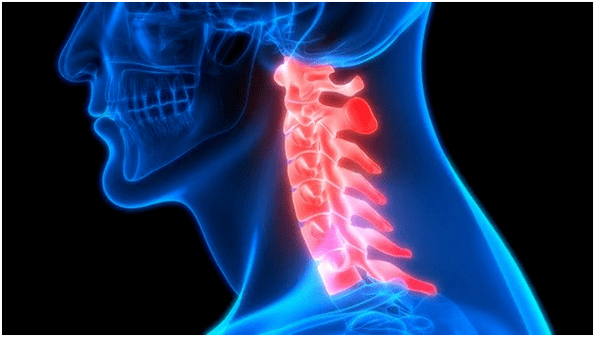
Although spinal cord injury is most commonly diagnosed in the lumbar spine, almost 50% of spinal cord injuries occur with cervical spine injury. This is due to the peculiarities of the neck anatomy: the absence of a developed muscular frame and massive vertebral bodies, high mobility contribute to the injury even without direct physical impact (for example, with a sudden stop or blow from behind during an accident, frequentso-called neck injury from the whip, caused by a sharp bend followed by a sharp extension of the cervical spine). Pain is a constant companion of any spinal cord injury.
Myositis
Myositis or inflammatory muscle diseases are a whole group of diseases characterized by muscle pain. The most common cause of joint muscle inflammation is a forced stop while performing any work, hypothermia, currents. Muscle pain can be a consequence of osteochondrosis of the cervical spine, the intervertebral hernia - the muscles take up most of the load on the neck, which eventually leads to overexertion, muscle spasm with reduced microcirculation and inflammation.
Neuralgia
Neuralgia is a condition in which the nerve fibers themselves become a source of constant pain impulses. The pain is paroxysmal, it can be intensified and caused by turning or tilting the head, cold weather. The cause of neuralgia is related to diseases of the spine - osteochondrosis, intervertebral hernia, scoliosis, etc. The immediate cause of pain is the irritation of the spinal cord roots when pressed into the intervertebral space, the muscle spasm, which disrupts the metabolism in the nerves that pass through the spasmodic muscles. Unlike neuritis or inflammation of the nerve, with neuralgia, the pain is periodic, there are no pathological changes in the nerve fibers themselves.
Heart deseases
Heart diseases such as angina, ischemic heart disease, atherosclerosis of the coronary arteries are often accompanied by pain that radiates to the neck, lower jaw, shoulder and left forearm. The pain may be accompanied by numbness, tingling in the skin, simulation of pain in osteochondrosis of the cervical spine with intervertebral hernia. Often, patients receive massage, physiotherapy, visit other doctors, although an electrocardiogram is sufficient to diagnose the cause.
A feature of this pain is the ability of anticonvulsant drugs that improve blood flow through the coronary arteries (isoketas, nitroglycerin) to relieve pain within minutes.
Back pain
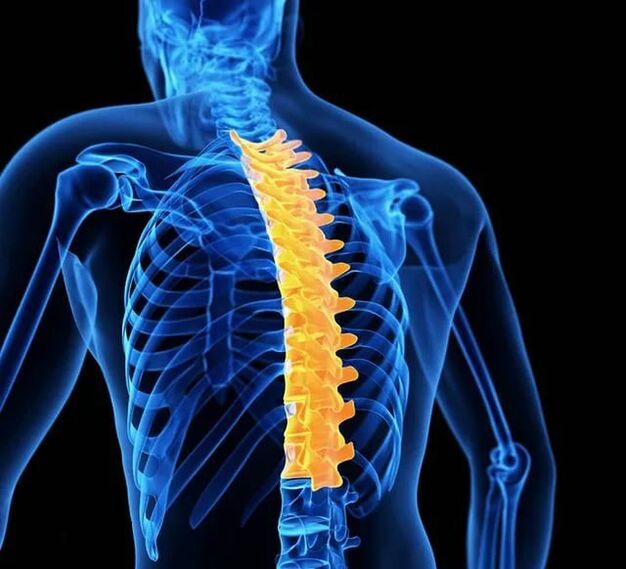
The thoracic spine consists of 12 thoracic vertebrae, each with a pair of ribs attached. Together they provide protection to the organs of the chest. The size of the thoracic vertebrae gradually increases, starting with 1 thoracic vertebra and further to the beginning of the lumbar spine - this is explained by the gradual increase of the load on them. The mobility of the middle part of the back is significantly lower than the mobility of the neck, the ribs provide additional protection, so traumatic spinal cord injury to the thoracic spine is less common.
Spine curvature or scoliosis
Scoliosis or scoliosis is a pathological curvature of the spine on many levels. The causes of scoliosis are not yet known exactly, the disease begins in childhood. Lack of physical activity, weakness of the back muscles, improper posture and organization of the workplace of students are considered as contributing factors. Due to strong curvature, reduced load distribution and biomechanics of the spine, overexertion of the muscles that compensate for part of the load,I get upchronicpain on the back.
Arthritis (vertebral arthritis)
The intervertebral joints together with the intervertebral discs join the spine into one whole. Each vertebra has 4 articular surfaces that form joints with adjacent vertebrae. Like any other joint, the intervertebral joints can become inflamed. This condition is called spondyloarthritis. There are two main causes of inflammation of the intervertebral joints. These are systemic rheumatic diseases (such as rheumatoid arthritis or ankylosing spondylitis) or reactive inflammation that occurs in response to increased loads on osteochondrosis, scoliosis and other pathologies of the spine. Inflammatory joints lose their function: stiffness of movements, stiffness of the spine, prolonged back pain.
Gastrointestinal disorders and back pain
Diseases of the abdominal organs are often the cause of reflected pain in the back and spine. There is also a direct relationship between pathologies of the gastrointestinal tract and diseases of the musculoskeletal system. Diseases such as chronic colitis or gastroenteritis are the background for vertebral arthritis or osteochondrosis of the spine.
Most often, the pain reflected in the back occurs with gastric ulcer and duodenal ulcer, with septal hernia, acute or chronic pancreatitis. This phenomenon arises from the peculiarities of the sympathetic and parasympathetic systems, whose nerve fibers are present in every organ of the abdominal cavity. Part of the perceived pain impulses returns to the roots of the spinal cord, simulating pain in the spine and back.
Kidney disease and back pain
The kidney is a paired organ located in the retroperitoneal space, which, as in the case of the abdominal organs, is closely connected by nerves to the roots of the spinal cord. In the presence of inflammation, stones or other pathologies of the urinary system, part of the impulses of pain reach the spinal cord, simulating a disease of the spine.Symptoms of back paincan occur with acute pyelonephritis, renal colic, renal abscesses. A characteristic symptom is the tension of the back muscles in the projection of the kidneys, which occurs due to inflammation of the kidneys or with an abscess of the tissue that surrounds them.
Pain in the lumbar spine
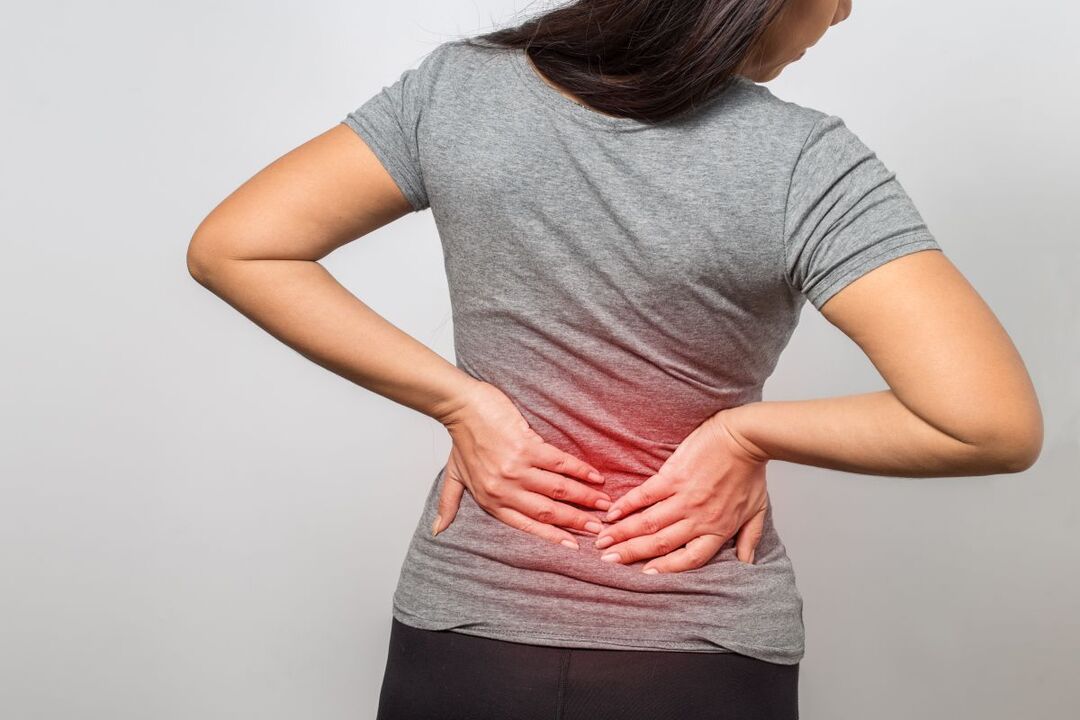
The lumbar spine has the most stress. Up to 60-70% of the adult population in developed countries complain of back pain. This is a favorite localization of intervertebral hernias. A patient is most often diagnosed with 2-3 hernias on the lumbar spine. Also, pain in the lower back and sacrum often occurs with gynecological and urological pathologies.
Intervertebral hernia
Intervertebral hernia is the result of long-term osteochondrosis of the spine. While relatively small loads are placed on the intervertebral discs in the area of the cervix, in the lumbar region each disc has enormous pressure. A healthy disc is able to compensate for any weight, due to the semi-fluid core, which acts as a hydraulic shock absorber. However, due to osteochondrosis, the fibrous and strong cartilage (fibrous ring) that extends along the periphery of the intervertebral disc loses its elasticity and strength and some of its parts may crack. With a sharp increase in load, for example, when lifting weights, the pressure inside the diseased disc increases, due to which its contents can actually "shoot" through the damaged cartilage, falling into the lumen of the spinal canal - thus formingintervertebral hernia.
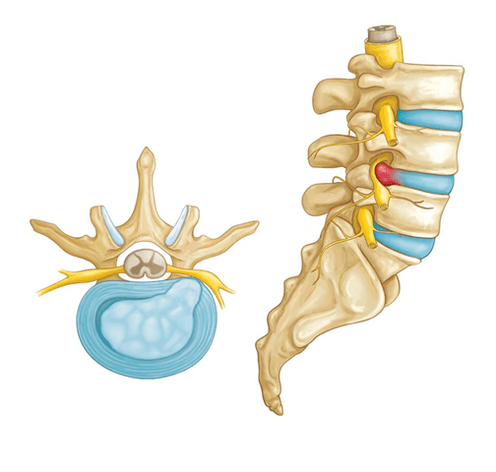
Fragments of the nucleus that have fallen out of the disc press on the spinal cord and the roots of the spine. As a result, there is swelling of the nerve tissues and disturbance of blood circulation, accompanied by severe pain and protective muscle spasm. The pain can be unbearable, up to the need to use analgesic drugs. A feature is the radiation of pain in the lower extremities. There may be reduced sensitivity to pain, tingling and numbness of the skin of the lower leg and thigh.
Intervertebral disc protrusion
The main difference between the protrusion of an intervertebral disc and the hernia is the preservation of the integrity of the fibrous ring. The cause of the pain is the compression of the spinal cord and its roots with a protrusion along the periphery of the intervertebral disc. However, if the procedure is continued, the protrusion can easily turn into a hernia. The symptoms and pains are similar to those of disc herniation, as the severity of the pain syndrome depends not only on the size, but also on the location of the protrusion or hernia.
Spinal fusion
Excessive loads and degenerative-dystrophic processes in the spine can lead to ossification of cartilage tissue, which is saturated with calcium salts and turns into sharp protuberances of cora bone or growths that appear along the periphery of the body. As the process progresses, these estuaries can merge with the same growths in the body of adjacent vertebrae. Over time, all the vertebrae develop together, the spine loses its flexibility and elasticity. The pain occurs due to irritation of the spinal cord and its roots, reactive inflammation and dystrophy of the soft tissues, ligaments and muscles that surround the spine.
Rickets
Rizitis is called severe pain resulting from circulatory disorders and ischemia of the spinal cord roots, strangled by a hernia or protrusion with osteochondrosis of the spine. Various disorders of skin sensitivity in the buttocks, perineum, thighs and lower legs are possible. Laughing sciatica leads to muscle atrophy and weakness. A typical symptom is pain along the sciatic nerve, which is aggravated by movement, weight lifting and cold weather. This condition is called sciatica or sciatica.
Infection of the spine
The vertebrae are made up of spongy bone tissue rich in bone marrow. When an infection enters the bloodstream in the body of the vertebrae, an inflammatory process can occur - osteomyelitis. The gradual disintegration of bone tissue is accompanied by necrosis - this image is also characteristic of tuberculosis of the spine. Pain can occur both due to irritation of the nerve endings and due to pathological compression fractures of the spine, which weaken due to inflammation.
Gynecological and urological diseases
Pathologies such as cervical cancer, endometriosis or adnexitis (inflammation of the uterine appendages) in women, prostatitis or prostate cancer in men are often accompanied by severe pain in the lumbar spine. The nature of the pain is explained by the irritation of the nerves caught in the area of inflammation or by the development of nerve trunks by a tumor.
The back muscles ache along the spine
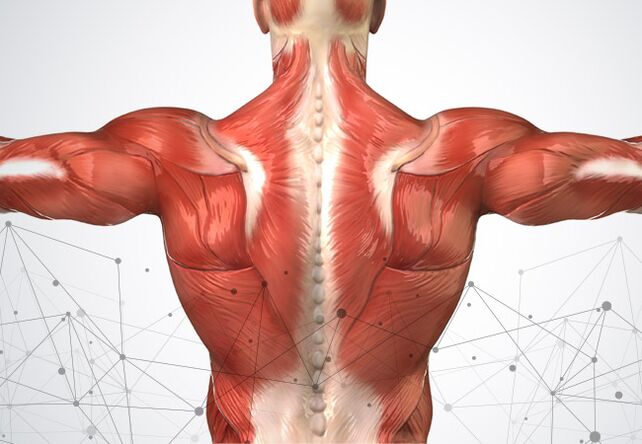
Well-developed back muscles are a sign of a healthy spine, as the muscular corset relieves stress and also stabilizes the spine. In chronic diseases of the spine, the muscles are subjected to excessive loads, which the weak and atrophied muscles can not withstand. As a result, muscle spasm occurs, and due to metabolic disorders in the muscles and pain. This condition is called myoperitoneal syndrome, which is characterized by osteochondrosis of the spine, hernias, and protrusions of the intervertebral discs.
Postoperative pain
Spinal surgeries are usually accompanied by extensive trauma - to stabilize and restore the integrity of the vertebrae, doctors may resort to metal structures, screwing in the vertebrae, and removing unviable tissue. The pain in this case is not only due to the disease itself, but also to the surgery. With proper rehabilitation and postoperative care, the pain will gradually disappear. However, if in the postoperative period you neglect the instructions of the doctors and ignore the obligatory exercises, the pain can become chronic.
How are the causes of back pain diagnosed?
For the diagnosis of back and spine pain, it is necessary to seek timely medical help from a qualified neurologist. In the first stage, a neurological examination, patient examination, study of reflexes and symptoms are performed. An experienced and competent doctor is well aware of what diseases back and spine pain have for specific reasons and features.
Back pain for no apparent reason should be especially careful. This can be with reflected pain of other organs and systems, with tumors and diseases of the spinal cord.

To find out why your back and spine hurt, a neurologist may prescribe an MRI scan. It is the most effective and safe method for diagnosing almost all possible causes of back pain. The procedure is based on the ability of magnetic fields and radio waves to give clear and detailed images of the spine and spinal cord without the use of X-rays and other harmful agents.
How to relieve back pain
To relieve, but not cure, back pain, let us take analgesics for several days, something that is necessary to wait for the advice of a specialist. Most often, non-steroidal anti-inflammatory drugs or NSAIDs are used for this purpose. However, it is important to remember that this group of drugs can cause dangerous side effects, the likelihood of which increases with prolonged use. That is why it is important not to postpone the visit to the doctor and the examination for later. treatmentillnessesspineand reasonspain on the back.
Treatment of pain in the spine
As mentioned earlier, the effectiveness of back pain treatment depends on how accurate the diagnosis is. Despite the obvious, many patients "cure" pain for years, but not the disease itself, postponing a visit to a doctor each time, turn to traditional healers, osteopaths and chiropractors. In addition, for some diseases of the spine, such procedures are not only contraindicated, but also dangerous.
There are effective and scientifically proven treatments for variouskinddiseases they causepain on the back. . . Many of these require the patient's perseverance and perseverance in fighting the disease. It is important to remember that there are no pills or injections that can cure osteochondrosis - only you can do that, with hard training and exercise that a neurologist will show you.
Which doctor should I go to for back pain?
Back pain is one of the most common neurological symptoms that occurs due to the involvement of nerves and spinal cord in the pathological process. Therefore, the first specialist, whose consultation it is necessary to receive in case of pain in the spine, will be a neurologist. Based on the results of the examination and the MRI scan, you may need to consult another doctor. If the back pain is caused by heart disease, the patient is referred to a cardiologist, if the problem is in the digestive system, to a gastroenterologist. But more often the pain syndrome is associated directly with the pathology of the spine.

















































